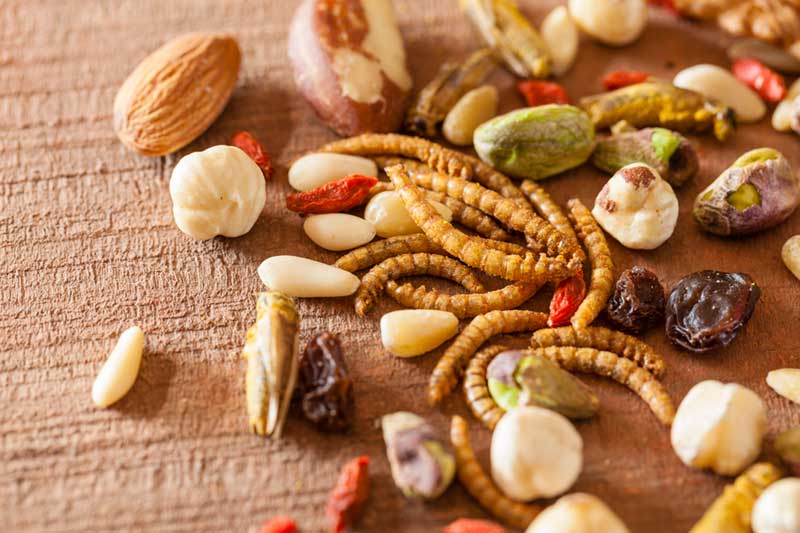
The consumption of insects, also known as “entomophagy,” has been touted as an up and coming wellness/health food trend for a few of years now. In fact, we at Spa Executive hat tipped it late last year as something to watch in the coming months. Were we right about this? Or is everyone, including us, who is buying the idea of insects as a healthy and sustainable protein source, totally off base?
Much of the world already eats insects
Proponents of entomophagy point to the approximately 2 billion people around the world who already eat insects all the time. It’s actually common to cultures in many parts of the world, including North, Central, and South America; Africa, Asia, Australia, and New Zealand.
Beetles are the most commonly consumed insect, followed by caterpillars, bees, wasps, ants, grasshoppers, locusts, and crickets. In total, about 2,000 insect species are considered edible, and are consumed in 80% of the world’s countries. In places like Mexico, crickets are a standard bar snack, in place of peanuts or pretzels. In many places they’re served as street food and sold as snacks. But they’re also part of gourmet culture. Thailand’s Bang Phlat district, for example, the restaurant Insects in the Backyard creates incredible looking dishes made with silkworms, giant water beetles, grasshoppers, ants and caterpillars.
In the Western world, a very few restaurants have added insects to the menu, and Ikea recently started talking about about selling a mealworm burger. Also, celebrities like Angelina Jolie and Justin Timberlake are vocal supporters (Timberlake served “ants coated in black garlic and rose oil, and grasshoppers” at a recent album launch). But people are still mostly put off by the idea, and insect consumption hasn’t moved beyond the novelty factor of food fairs and exhibitions.
Insects are good for you
Could this change with the right marketing and packaging?
Advocates point to the nutritional value and sustainability of insects, which is what makes them compelling on the health food market. Move over, pomegranate; they’ve even been touted as the next “superfood.” In 2016 that was the gist of headlines about cockroach milk, which scientists were quite excited about, but which isn’t going to be ready for mass consumption any time soon.
Insects are highly nutritious; the majority of them are rich in healthy fats, iron, and calcium, and low in carbohydrates. This means people are marking them as a food that could potentially combat both obesity and malnutrition. And it’s regularly pointed out that crickets – currently the stars of the insect foodie show – are a complete protein with all nine essential amino acids. They also contain omega 3 and 6 fatty acids, and are high in both calcium and vitamin B12.
Insects are good for the planet
Insects are also viewed as an environmentally friendlier alternative to meat, of which the factory farming is destroying natural environments and releasing unmanageable amounts of CO2 into the atmosphere. The United Nations has gotten behind entomophagy with the 2013 report Edible Insects: Future prospects for food and feed security. And the Independent recently reported that insect-farming businesses claim their environmental footprint is relatively minor, and that lean insect protein is a healthier choice than meat or other animal proteins.
As the edible insect market is projected to grow dramatically between now and 2024, more and more products are being developed with a hope of convincing people that insect consumption is part of a healthier, more sustainable future.
Will luxury spas – many of which exist in markets where insect consumption is common, such as Thailand, China, and Mexico – soon see wealthy consumers sipping on cricket shakes and munching on bug bars and grasshopper salads? Or is this supposed fad destined to never actually take off among a cohort that will remain steadfastedly squeamish?
Here are a few of those insect-based health-food products:
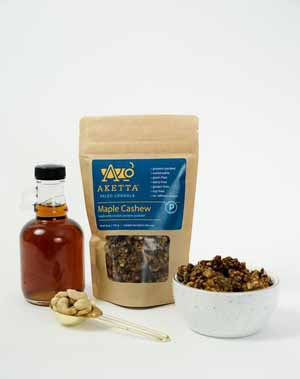 Cricket Powder (Cricket Flour): According to South African producers Entomo Farms, both their cricket and mealworm flours are naturally gluten-free, delicious, and nutritious options that can be used in “almost anything you can imagine.” (Recipes for cricket powder smoothies abound online.) According to the description, “Cricket powder has a pleasant nutty, earthy aroma and flavour, a soft powdery texture and a light brown appearance.”
Cricket Powder (Cricket Flour): According to South African producers Entomo Farms, both their cricket and mealworm flours are naturally gluten-free, delicious, and nutritious options that can be used in “almost anything you can imagine.” (Recipes for cricket powder smoothies abound online.) According to the description, “Cricket powder has a pleasant nutty, earthy aroma and flavour, a soft powdery texture and a light brown appearance.”
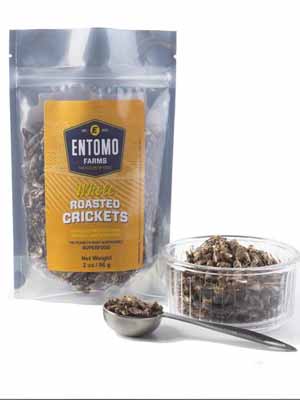
Whole Roasted Crickets and Mealworms: Whole Roasted insects are recommended as a great way to add flavour and extra nutrients to salads, soups, stews, or sandwiches

Toasted Cricket Bitters: These bitters, from American company Trouble Makers Incorporated, are cocktail bitters made with toasted crickets, rose hips, sarsaparilla, pepper, dandelion root, gentian, and cinnamon.
 Maple Cashew Paleo Cricket Protein Granola: Cricket protein granola from US-based Aketta is Paleo Certified, high in protein, and tastes like homemade maple granola, says Aketta. This granola contains cricket protein powder, almonds, cashews, pepitas, flax seeds, and prebiotic dietary fibers.
Maple Cashew Paleo Cricket Protein Granola: Cricket protein granola from US-based Aketta is Paleo Certified, high in protein, and tastes like homemade maple granola, says Aketta. This granola contains cricket protein powder, almonds, cashews, pepitas, flax seeds, and prebiotic dietary fibers.
 Cricket Drinks: Danish producers Syngja infuse cricket powder into beverages. Drinks come in Apple-Cherry, Beetroot-Seaberry, and Spirulina-Acerola, and are made with all organic fruits and vegetables with no added sugars or preservatives. According to the website, “the crickets also convey a lingering sense of umami (due to their high protein content), for a pleasant and rounded taste experience.”
Cricket Drinks: Danish producers Syngja infuse cricket powder into beverages. Drinks come in Apple-Cherry, Beetroot-Seaberry, and Spirulina-Acerola, and are made with all organic fruits and vegetables with no added sugars or preservatives. According to the website, “the crickets also convey a lingering sense of umami (due to their high protein content), for a pleasant and rounded taste experience.”
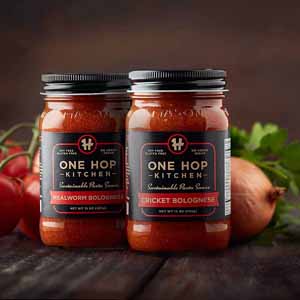 Cricket and Mealworm Tomato Sauces: Canada’s One Hop Kitchen boasts that each jar of bug sauce saves over 1900L of water and tastes delicious. The sauces are packed with protein and vitamins, and “save over 300 gallons of water during production when compared to a beef based sauce.” The mealworm Bolognese, meanwhile, “has the umami and flavour notes of Parmesan cheese.”
Cricket and Mealworm Tomato Sauces: Canada’s One Hop Kitchen boasts that each jar of bug sauce saves over 1900L of water and tastes delicious. The sauces are packed with protein and vitamins, and “save over 300 gallons of water during production when compared to a beef based sauce.” The mealworm Bolognese, meanwhile, “has the umami and flavour notes of Parmesan cheese.”
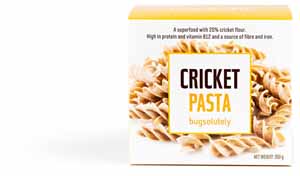 Cricket Pasta: Well you need something to put that delicious sauce on. Bugsolutely Cricket Pasta is “a sustainable superfood containing 20% cricket flour.
Cricket Pasta: Well you need something to put that delicious sauce on. Bugsolutely Cricket Pasta is “a sustainable superfood containing 20% cricket flour.
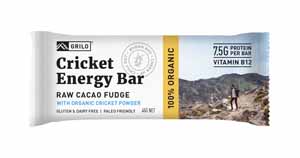 Cricket Energy Bars: These bars from Grilo, in Australia, are a 100% organic insect bar made with dates, pepitas, sunflower seeds, almonds, cricket powder, tahini, chia seeds, cacao nibs and cacao powder. It’s gluten free, dairy free, Paleo friendly – and wrapped in biodegradable packaging.
Cricket Energy Bars: These bars from Grilo, in Australia, are a 100% organic insect bar made with dates, pepitas, sunflower seeds, almonds, cricket powder, tahini, chia seeds, cacao nibs and cacao powder. It’s gluten free, dairy free, Paleo friendly – and wrapped in biodegradable packaging.
Spa Executive magazine is published by Book4Time, the world’s most innovative spa, salon, wellness, and activity management software. Learn more at Book4Time.com



